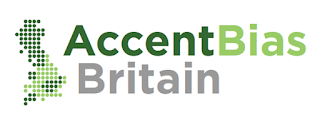What do you think of when
you hear someone speak with a Brummie accent? How about when somebody speaks
with a West Country accent? Do you think that some accents are more attractive
or prestigious than others? If so, it’s possible that your judgements of these
accents are influenced by accent bias.
As part of the Accent Bias project led by academics
at Queen Mary University of London and the University of York, over the next
few weeks we’ll be uploading a series of Digest posts that discuss the effects
of accent bias.
In the first post of
the series, we focus on a 2007 study by Nikolas Coupland and Hywel Bishop that
investigated how people perceive different types of British accents, looking
specifically at whether some accents were evaluated more positively than
others.
In their 2007 study, they
report on a BBC survey that collected 5010 respondents’ evaluations of 34
different accents. To assess these evaluations, they created an online survey
where participants where asked a series of questions about the prestige and
pleasantness of the 34 accents. This included asking participants direct
questions such as “How much prestige do you think is associated with this
accent?”, and “How pleasant do you think this accent sounds?”. The participants
rated their judgements electronically via a digital survey by clicking a seven-point rating scale,
where 1 is low rating whilst 7 is high rating. This is what is referred to as a 'label study' in that participants were not asked to listen to a recording of the accent, but were simply asked to respond to different accent 'labels', such as 'Asian English' or 'Southern Irish'.
Participants also were
asked to indicate where in the UK they were from, how old they were, and their
gender. The researchers also asked a series of questions about whether the respondent liked hearing different accents to test whether their attitudes towards accents and dialects influenced their ratings of the different accent labels.
Coupland and Bishop find that, for
social attractiveness, accents such as Standard English, Southern
Irish, and Scottish are generally positively evaluated, whilst
accents such as Birmingham, South African, and Glasgow were
typically down-rated – that is, they score much lower. For prestige, however,
they observe a slightly different pattern. Received Pronunciation (or
the ‘Queen’s English’) scores much higher in terms of prestige than it
does for social attractiveness. Whilst accents such as Birmingham and Asian
English score poorly across the two different scales.
Interestingly, accents
such as Southern Irish English, Newcastle English and Afro-Caribbean
English are rated far higher for attractiveness than for prestige, whereas London
English, North American-accented English, South African-accented
English and German-accented English are all ranked higher for
prestige than for attractiveness.
Whilst these ratings
reveal more general trends of the social evaluation of different UK accents, Coupland and
Bishop suggest that these evaluations may be influenced by the respondents' social characteristics, such
as whether they are male or female. Focusing just on ‘prestige’, on the whole,
Coupland and Bishop find that women are more likely to evaluate a given accent
as prestigious than men. They also find that where the respondent is based in the UK appears to play a role in their evaluation of a given accent, with participants more
likely to evaluate in-group accents as more favourable than others. In other
words, Scottish speaking participants were more likely to evaluate Scottish accents more positively than respondents from other parts of the
country. Similarly, they also observe that the respondents’ age is likely to
influence their evaluation, with the oldest age group tending to show a preference for their own accents than all other groups. Lastly, they observe that
the more liberally-minded respondents who indicate that they appreciate accent
variation were more likely to rate non-standard
accents as more prestigious than their peers.
So, what does this all
mean? Well, Coupland and Bishop note several implications of this study. The
first is that language use is influenced by ideology – that is a widespread
system of ideas and values that governs a particular concept or social issue. For instance, they observe that there is a general tendency
to rate ethnically linked accents (Asian and Afro-Caribbean) and some of the
urban vernaculars (Birmingham, Liverpool, Glasgow) as lower in prestige and
attractiveness than non-ethnically linked and rural accents. They argue that this is because there is a widespread belief
that people should ‘speak properly’ and so accents that are further away from
more ‘standard’ varieties are typically perceived to be less attractive and
less prestigious than ones that are closer to the standard.
Whilst these findings may not at first seem very encouraging for speakers of non-standard varieties, Coupland and Bishop suggest it seems that there is seems to be a shift towards embracing more liberal attitudes towards accent variation, with younger respondents and those claiming that they like hearing different accents more likely to evaluate non-standard varieties as more prestigious and more socially attractive. So, it seems that although some people might think of certain accents as more attractive or prestigious than others, perceptions are gradually changing.
Given the fourteen or
so years since Coupland and Bishop conducted their study, it’s worth considering whether this liberal outlook has continued. Over the next couple of weeks, we’ll be
focusing on the Accent Bias in Britain project which, among other questions,
sought to investigate this issue. In the meantime, or more information on the
project, you can visit the Accent
Bias in Britain homepage.
You can also find further educational resources, including a Language
Investigation and a Teaching
Unit on our Teach Real
English! website.
------------------------------------------------------------
Coupland, Nikolas & Hywel Bishop (2007) Ideologised values for British accents.
Journal of Sociolinguistics, 11 (1):74-93.
This summary was written by
Christian Ilbury
https://doi.org/10.1111/j.1467-9841.2007.00311.x






